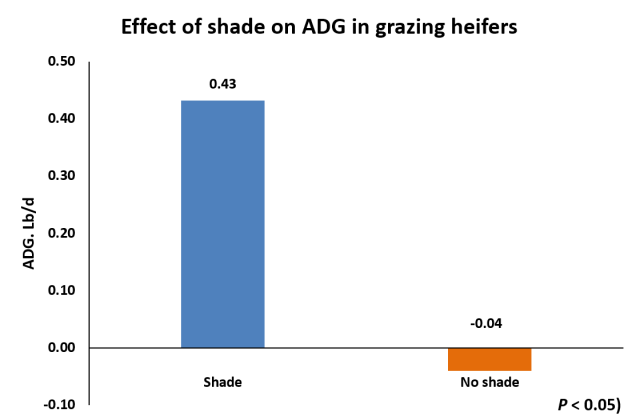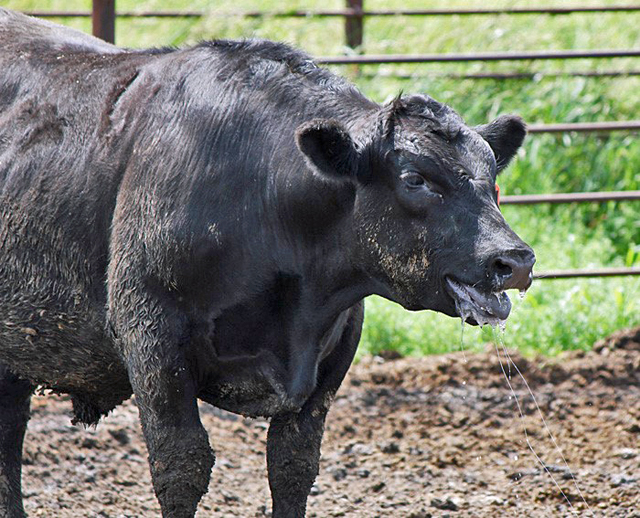Lautaro Rostoll, Jose Dubeux, and Nicolas DiLorenzo, University of Florida NFREC
Cattle producers in the Southeast have often asked questions about the need for shade, and its impact on performance. While plenty of information is available on heat stress on cattle fed finishing diets in the Midwest, surprisingly not as much information is available on heat stress by cattle grazing in the Southeastern U.S. It is for this reason that researchers at the North Florida Research and Education Center (NFREC) Beef Research Unit decided to conduct a study to evaluate the effect of providing artificial shade for replacement heifers grazing bahiagrass pastures through the summer.
You may be wondering why we are discussing shade in a December? There are two reasons for that: 1) this study has just been completed, so this is new information and 2) this may be a good time of the year to start thinking about the improvements needed before the summer heat arrives, so you are ready to take full advantage of summer forage growth. In a sense, just as it is recommended to start planning a winter feeding strategy in the summer, when commodity prices are low, now is the time to think about improvements to your summer pastures such as fences, water troughs, shade, and maintenance while it is cool enough to work without getting heat stressed yourself.
The artificial shade study
A total of 60 black-hided bred replacement heifers, that averaged 920 lbs. of body weight from the NFREC herd were enrolled in the study, which consisted of two treatments: artificial shade versus no shade while heifers were grazing bahiagrass pastures from July 17 to September 2, 2017. Heifers were allocated to each treatment balanced by breed, so that the same amount of Angus and Brangus heifers were in each treatment. Put-and-take heifers were used to maintain the same herbage allowance, thus minimizing any effect of forage availability on average daily gain (ADG). At the beginning and at the end of the study, heifers were weighed on two consecutive days to reduce the effect of gut fill on ADG. A total of 12 pens were used in the study: 6 containing shade and 6 without. Heifers in the shade treatment had one structure per pen with a shade cloth of 36 x 24 feet (Fig. 2).
Figure 3 below shows the effect of shade on the average daily gain (ADG) of heifers. During the 47 days of the study, a difference of 0.47 lbs/day in weight gain was observed in the heifers that had shade in their pens, versus heifers in pens without shade.

Fig. 3. Effect of shade on ADG in black-hided replacement heifers grazing bahiagrass during the summer.
Compared with other species, cattle cannot dissipate their heat load very efficiently. Cattle do not sweat effectively and the main cooling mechanism to dissipate heat is respiration. Heat stress can cause several problems in cattle, including reduced breeding efficiency, milk production, feed intake, weight gains and even death. At temperatures above 80°F, cattle will activate physiologic mechanisms to try to cope with heat stress, and that will ultimately increase the maintenance requirements of the animal, leading to a decrease in performance. Environmental conditions contributing to heat stress include minimal cloud cover, little or no air movement, high relative humidity, and overnight low temperatures above 70°F.
Take home message
This study, although very preliminary, is one of the first of its kind conducted in the Florida Panhandle. The results show a very marked effect on animal performance when cattle are provided with some basic heat mitigation options, such as artificial shade. While the results are perhaps not that surprising, the magnitude of the drop in ADG was: 0.47 lb/day in a study with only a six week six duration. Other data collected in this study will compare the amount of time spent in the shade vs. gazing, and the effects on animal temperature by means of various devices placed on the heifers during the study. Stay tuned for more information on this in the future.
- 2026 Florida Bull Test Sale – January 17 - December 19, 2025
- Stretching Hay Reserves is Critical during this “Flash Drought” - September 26, 2025
- 2025 Florida Bull Test Sale Sets Average Price Record - March 7, 2025


